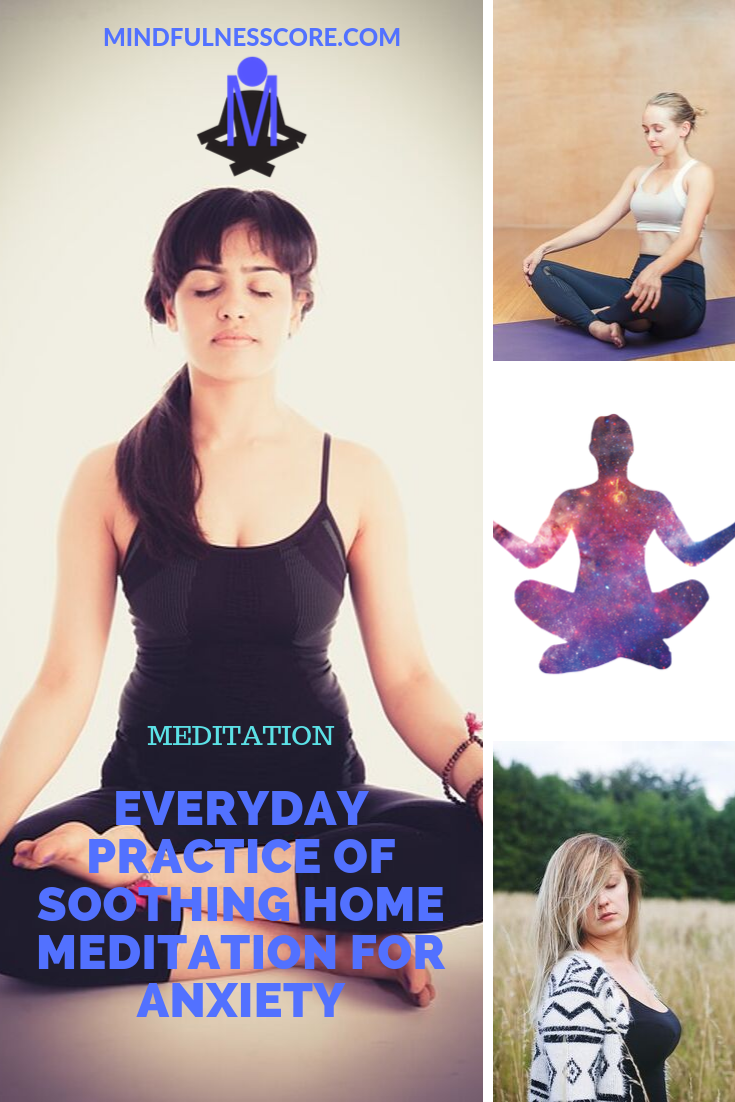Everyday Practice Of Soothing Home Meditation For Anxiety

How to Deal with Anxiety Using Meditation
Welcome to the modern era in which a myriad of advancements are focused on making lives easier and more comfortable. However, the excessive competition of this mechanical era has had various side effects as well, the gravity of which is usually lost on a lot of us. Stress is now a phenomenon that is known to almost all of us. Experiencing stress on a fairly consistent basis is no longer taken as a serious medical condition but rather an everyday occurrence for the majority of us causing an ever-increasing prevalence of anxiety. While it all sounds extremely grim, the good news is that there is something that you can do about it from the very comfort of your homes.
This is not going to be one of those stereotypical articles which highlight the factors of your everyday life that you should avoid in an attempt to prevent stress, rather, we are going to take a more practical approach, acknowledging the inevitability of stress and anxiety in the present times, and then enlightening you with a strategies and tactics for effectively coping with it.
What if we told you that something as simple as mindful exercises or consistent meditation is all that you need to address this apparently gigantic challenge of anxiety? It is understandable for a layman that relaxation is of paramount importance when it comes to coping with stress and anxiety. But what most of us fail to realize is that lying on your couch after a busy, hectic day with your favorite show running on the TV in the background is not registered as relaxation by your body. It is the natural relaxation response that ought to be activated if you want to reap the true benefits and cope with anxiety. And this is where the mindful exercises and meditation step in.
Let us walk you through a list of everyday practices for home meditation that you can use to effectively protect yourself against the harms of consistent stress and anxiety.
Deep Breathing – Traditional Yet Effective
It is beyond comprehension why a lot of people fail to take this technique seriously. Deep breathing is the very core of meditation that can be combined with various other meditation practices such as muscle relaxation or mindfulness exercises, its known effects on reducing stress and anxiety are unquestionable, it can be easily practiced at home, in your office, or literally anywhere and doesn’t take more than a few minutes of your precious time.
Procedure
- Sit in a comfortable position and keep your back straight. Place one of your hands on your stomach while the other one rests on your chest.
- Take a deep, slow breath through your nose. With the rise of your hand on the belly, feel the air filling in your body. The other hand resting on your chest should witness minimal movement.
- After keeping the air in for a couple of seconds, start to slowly exhale it out through your mouth. Use your hand that is on your tummy to feel the contraction of the abdomen and consequently the air rushing out of your body. Again, the other hand should move minimally.
- Continue to inhale through the nose and exhale through the mouth. Take deep breaths and exhale slowly. Continue to feel the movement of your lower abdomen.
Remember that the entire purpose of the breathing exercise to take deep, slow breaths using your lower abdomen instead of your upper chest. You need to ensure the entry of as much fresh air into your lungs as you possibly can. With an increased supply of oxygen due to deep breathing, the levels of anxiety will slowly start to fall.
Body Scan – Getting To Know Your Body
Body Scan is a simple meditation technique that calls for focusing on different body parts. As the name suggests, this technique involves isolating each of your body parts, starting at your feet and going all the way to the face, and individually focusing on each of the body parts in order to get a sense of them. The goal here is to know what the body part feels like. There is no movement involved, neither are you supposed to label the part or the feeling as good or bad.
Procedure
- Lie down on the floor in a comfortable position. Keep your legs crossed and relax your arms on the side. Being with slow, deep breathing to promote relaxation. It is entirely up to you whether you want to keep your eyes closed or open.
- Now start to shift your focus to the toes of one of your feet. With continuous deep breathing, try to feel the sensation in your toes. With each inhalation, try to imagine the air going all the way down to your toes. Focus on the toes for a couple of minutes.
- Once done, you can move on to a different part of the foot, for instance, the sole and repeat the same procedure. Continue moving on to the different parts and follow the same procedure until all parts of the body have been covered.
- Once all parts of the body have been scanned, stay still and quiet and get a feel of your body as a whole. Now open your eyes very slowly if you had closed them in the beginning.
Progressive Relaxation Of The Muscles – A Perfect Combo For Deep Breathing
The next in our list of following a home meditation regime to cope with stress and anxiety is the progressive muscle relaxation. It is a home meditation technique that spans over a continuous loop of contraction and relaxation of a muscle group of your choice. The purpose of this technique is to sensitize different parts of your body to the true sensation of tension and relaxation. Once the goal is accomplished, you can easily identify the early symptoms of muscle tension which are usually accompanied by stress and anxiety. By effectively relaxing the muscles, you would then be able to activate the natural relaxation response of your mind.
Procedure
- After the body scan has been completed, slowly try to bring your entire attention again to the chosen muscle group, for instance, your foot.
- Start to contract the muscles of your foot slowly. Your goal is to squeeze them as hard as possible. Keep the tension as you slowly count to 10.
- Next, start to relax the muscles slowly. Try to get a feel of tension fading away as your foot begins to get loose and comes to its natural resting position.
- Keep the relaxed position for a few seconds while continuing the deep, slow breathing.
- Now follow the same procedure for your other foot.
Remember, the loop of contraction and relaxation in the muscle of your choice must proceed slowly. Moreover, the goal is to “ONLY” contract or relax the muscle group that is intended. Identical to the body scan, the procedure for progressive muscle relaxation is recommended to begin at the feet and brought all the way up to the facial muscles.
Mindfulness Exercise – Be In Charge Of Your Mind
Last but not the least in our list of everyday practices for home meditation to cope with stress and anxiety is the mindfulness exercise. It is understandable that a common cause of excessive anxiety is dwelling on the past, or being overly concerned about the future. Mindfulness exercise is an effective strategy against anxiety as it brings your entire focus to a single point – “The Present”. The principle behind mindfulness exercise is to rewire your brain or attention to a repetitive, harmless event that is happening in the present.
Procedure
- Make sure that you are in a calm, quiet, and peaceful environment with no distractions or interruptions.
- You can choose to either sit on the floor with your legs crossed or get a chair and sit comfortably with your back straight.
- Now, find a harmless, repetitive event that is happening in the present. It could be anything, like the flame of a candle, the tick-tock of a wall clock, repetition of certain words, the chirping of the birds, falling rain, or even activities such as rhythmic walking.
- Keep focusing on the event unless you are completely involved. The more you are involved, the better it will be for your mind to isolate itself from dwelling in the past or being over-indulged in the future, and the more it will depart the stress and anxiety out of it.
Remember that being interrupted by the thoughts during the process is common and justified. Avoid fighting these thoughts and rather be gentle in getting your focus back to the present event to activate the natural relaxation response.
Conclusion
If you have tried these home meditation techniques in the past but to no avail, now is the time for you to question, WHY? What were you lacking that prevented you from reaping its true benefits? The answer lies in “Consistency”. It is to be kept in mind that meditation takes a bit of practice before you can master the techniques and enjoy its true benefits. With irregular attempts at meditation, you will fail to learn and apply the techniques properly, consequently failing to experience its effect on reducing stress and anxiety. While it is recommended to meditate for 30 minutes every day for optimum results, you can start with just 5 minutes per day and make your way up from there. Starting slow and keeping the burden at minimal will go a long way in promoting consistency. Now, along with keeping your mind and spirit healthy, it’s also a good idea to look into some natural alternative medicine, there are many of super-healthy herbs and foods that will enhance the meditation experience. One of the very effective natural herbs is Curcuma Longa, Turmeric root. There are many health benefits of Turmeric, including consistent positive effects on depression and anxiety.

